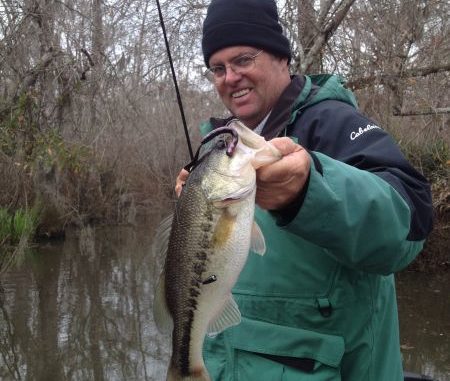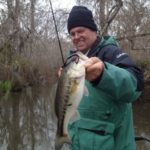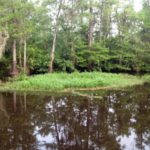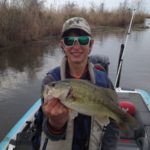
The Pearl River offers some great bass-fishing opportunities — even when the weather turns cold. And this Florida Parishes angler knows exactly how to target them.
On a gloomy February day, Jeff Bruhl was fishing waters he knew better than the chips in his truck windshield.
Pulling up to a big drain with a falling tide rushing out of it, Bruhl cast his red-shad worm to an old, massive cypress tree. He let the bullet weight pull the soft-plastic to the bottom and meticulously worked his worm, almost dragging it along with short hops.
One of the hops was interrupted by an unmistakable “thump,” and Bruhl knew immediately what was about to happen.
“There’s one,” he said.
With his rod in the 12-o’clock position, he reeled down to 9 o’clock and set the hook, trying to penetrate the 3/0 EWG hook into the toughest and boniest part of the bass’ mouth.
He succeeded, and the 1½-pound fish didn’t like what it was feeling. It tried pulling Bruhl’s terminal rig into the thickest of cover and made an attempt at snapping the 20-pound fluorocarbon, but the fish failed miserably.
It was just one of the many that took a boat ride home in Bruhl’s on-board jacuzzi.
The Covington angler regularly fishes the Pearl River this time of year, and has great success with the bass there.
But before Bruhl even thinks about going to the Pearl, he checks the water level stretching back to a couple weeks.
Ignore this step and you most likely will only get some casting practice accomplished.
“If the Pearl River gauge is 9.5 feet or less, then the water will be pretty clear throughout the whole system,” Bruhl said. “If it’s above that, the water starts getting into the woods and it muddies up a lot of the drains.”
However, too much of a good thing can be a bad thing, as in the case of a constantly low river.
“Last year, it got so low for a long time in the winter — December and January — that Wastehouse was so clear you could not even fish it,” he explained. “You could see like 10 feet down.
“It needs to come up and down to keep the water stained, but you don’t want these long periods of 14 to 15 feet on the gauge where it muddies up everything.”
Timing your trip for a falling river stage is the best of all worlds.
“When it falls from, say, 10 to 7 feet in a week’s time, that’s when you want to go because those drains start pulling water out of them, and in the wintertime the bass will get in there and eat those crawfish coming out of the drain,” Bruhl said.
When the river is high, it’s not a total waste of time, however. It certainly is less than ideal conditions when the river is up, but you can still catch a mess of green trout, according to Bruhl.
“You have to go farther to the east to catch them because it won’t be quite as muddy around those areas,” he said.
During high-river periods, Bruhl focuses on areas like Buck Bayou and Bullfrog Bayou because they stay clean.
Of course, a big part of having success on the Pearl is playing the tides, according to Bruhl.
“If the water is falling due to a tide or wind — or if the river is just falling — then I will go fish drains,” he said. “Anything that is coming out of a pond or the woods that will have clean water and that’s pulling out into the main body of water, being the Middle or the West Middle, is what you want to fish.”
But when the water is rising, Bruhl doesn’t abandon the drains.
“When the water is draining, there is constantly food coming out of that run-out so when that shuts off, the fish will just spread out down the bank,” he said. “You need to figure out if they are north or south of the drain.
“They tend to go in the direction where the water clarity is the best.”
Where bass are on a drain is dictated by the water temperature, according to Bruhl.
“If the water is at a good level and you get a warm-up to 60 degrees, the bass will be up shallow,” he said. “But if it is a cold, wintery day, where you have air temperatures in the 40s and 50s and water temperatures in the low 50s, they might be slap in the middle of the drain.”
Bait selection — not only the color of the lure, but also the style — can be vital to success. Matching the style of lure to the water temperature can make or break your trip, he said.
“I like the water temperature to be 55 degrees and above for spinnerbaits,” Bruhl said. “For some reason, if it is colder than that, they are not really active and they are not going to chase that spinnerbait.”
Bruhl typically likes throwing red spinnerbaits — with red in either the the skirt or the blade — because he feels it mimics the crawfish on which bass are feeding.
But on colder days, Bruhl’s go-to-bait is a Texas-rigged soft-plastic or a Stanley jig with a sapphire green trailer.
Paying attention to the weather not only the day of your trip but also to the days before you head out can really pay dividends in February because it helps with bait selection.
“If it is a bluebird day, I might do more punching and throwing jigs on the bottom,” he said. “If it is more of a cloudy day, I will go with the spinnerbait or crankbait.”
Depth of water is another key factor when fishing in the winter, with Bruhl generally looking for the warmest water.
“If I go into the Middle or West Middle, I will go into those small drains that you can barely get your boat in,” he said. “A lot of times those shallower bodies of water will warm up a little bit quicker than the deeper water.”
Bass fishing in general is certainly not at its best after a cold front. High pressure and bluebird skies can make for a tough day, but there are some things you can do to increase your chances for success on these challenging days.
“A small Speed Craw will get you a lot more bites than bigger baits,” Bruhl said.



